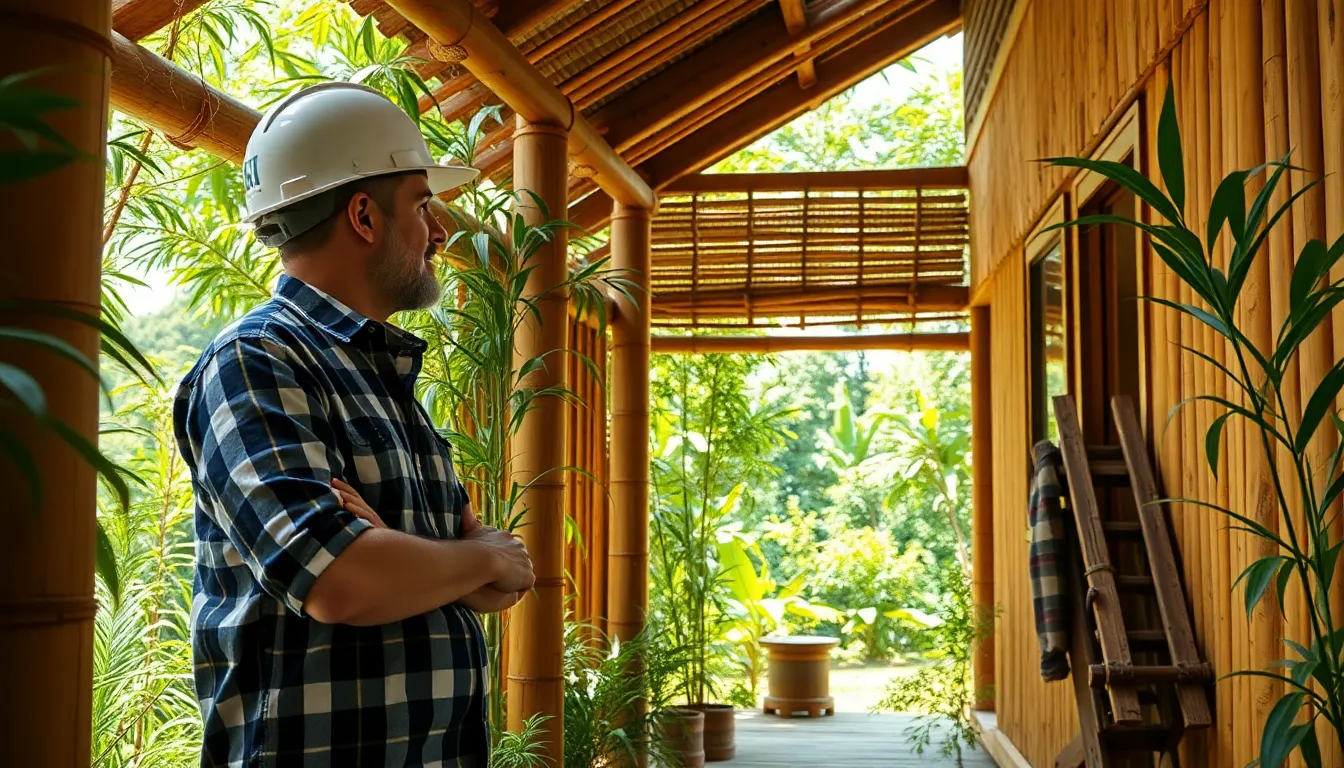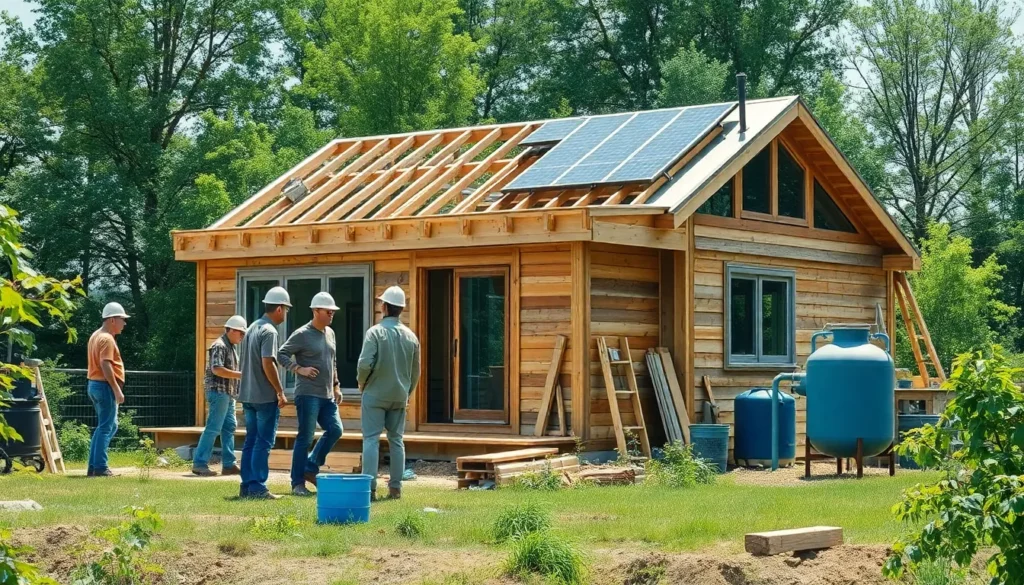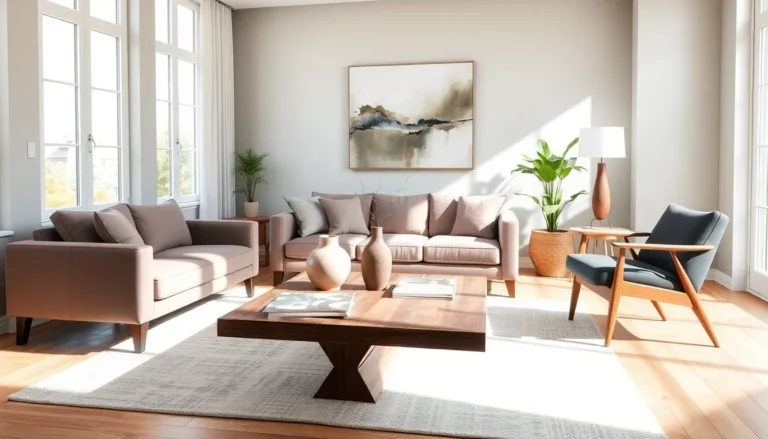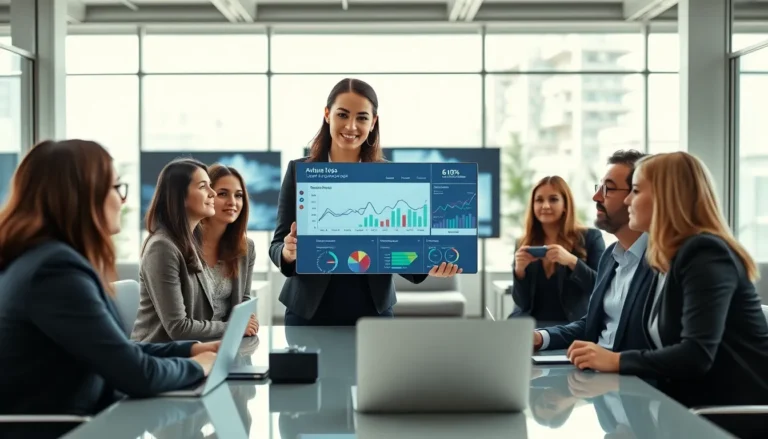In a world where the planet’s temperature is rising faster than a toddler on a sugar rush, sustainable living builders are stepping in like eco-friendly superheroes. They’re not just constructing homes; they’re crafting havens that promise to keep Mother Earth happy. Imagine living in a space that’s as gentle on the environment as a kitten on a cloud.
Table of Contents
ToggleOverview of Sustainable Living Builders
Sustainable living builders focus on creating homes that prioritize environmental health and resource efficiency. These builders implement practices that minimize energy consumption and reduce waste during construction. They often utilize renewable resources such as bamboo, recycled steel, and reclaimed wood in their projects.
Energy-efficient technologies play a significant role in sustainable homes. Solar panels, efficient insulation, and smart home systems contribute to reduced carbon footprints. These features not only lower utility bills but also enhance the occupants’ quality of life.
Water conservation is another key aspect of sustainable building. Rainwater harvesting systems and low-flow fixtures conserve this precious resource. Landscaping with native plants also contributes to a home’s sustainability by reducing the need for excessive irrigation.
Sustainable living builders often collaborate with architects and engineers to design spaces that blend seamlessly with their surroundings. They analyze the local climate and ecology to optimize natural light and ventilation in their homes. The aim is to create a harmonious balance between indoor comfort and outdoor ecosystems.
Adopting environmentally friendly materials is crucial for reducing a home’s overall carbon footprint. Sustainable living builders frequently research and select products that meet strict environmental standards. Certifications such as LEED (Leadership in Energy and Environmental Design) help consumers identify homes built with eco-friendly practices in mind.
Community engagement aligns with the goals of sustainable builders. By promoting local economies through sourcing materials and labor nearby, these builders foster resilient neighborhoods. Their efforts contribute to a broader movement towards sustainability, encouraging occupants to adopt eco-friendly practices in their daily lives.
Key Principles of Sustainable Building

Sustainable building revolves around key principles that prioritize environmental health and resource efficiency. These principles guide builders toward creating homes that co-exist with nature.
Eco-Friendly Materials
Eco-friendly materials play a crucial role in sustainable construction. Bamboo, recycled steel, and reclaimed wood serve as popular choices that minimize environmental impact. Builders select materials certified by reputable standards, such as LEED, to ensure compliance with eco-friendly practices. These materials not only reduce carbon footprints but also enhance the overall durability of homes. Utilizing local materials fosters community engagement and reduces transportation emissions. Many builders implement innovative recycling techniques to repurpose existing materials, thereby cutting down on waste. Overall, these decisions reflect a commitment to sustainability.
Energy Efficiency
Energy efficiency stands at the forefront of sustainable building. Incorporating technologies like solar panels and smart home systems lowers energy consumption and utility costs. Builders design homes that optimize natural light and enhance ventilation, creating comfortable living environments. Insulation materials that maximize energy retention are typical components of these homes, further improving efficiency. Integrating Energy Star-rated appliances ensures homeowners benefit from modern technologies while consuming less energy. Ultimately, these strategies contribute to a lower carbon footprint and promote a sustainable lifestyle for occupants.
Benefits of Choosing Sustainable Living Builders
Choosing sustainable living builders significantly impacts the environment and personal health. Their commitment to eco-friendly practices fosters better living conditions for both occupants and the planet.
Environmental Impact
Sustainable builders reduce the carbon footprint by implementing energy-efficient technologies and utilizing renewable resources. They focus on minimizing waste during construction, employing innovative recycling techniques to repurpose materials. Local sourcing for building supplies fosters community engagement and cuts transportation emissions. Eco-friendly materials like reclaimed wood and recycled steel enhance the durability of homes while promoting environmental health. By prioritizing sustainable practices, these builders help preserve natural resources and protect ecosystems. Their approach contributes to a greener future, aligning with global efforts to combat climate change.
Health Benefits
Health benefits arise from sustainable building practices. The use of non-toxic, eco-friendly materials enhances indoor air quality, reducing harmful pollutants. Features like optimized natural light and ventilation reduce reliance on artificial lighting, promoting well-being. Installing Energy Star-rated appliances helps lower energy consumption, creating a comfortable environment. Water-saving fixtures contribute to overall conservation efforts while preserving valuable resources. Homeowners living in sustainably built homes enjoy reduced utility bills and a healthier lifestyle, creating a lasting positive impact on their well-being. These initiatives encourage occupants to embrace eco-conscious habits in their daily lives.
Leading Sustainable Living Builders
Sustainable living builders lead the way in creating eco-friendly environments. Their commitment to environmentally conscious construction shapes the future of housing.
Notable Projects
Representing innovation, various notable projects highlight the success of sustainable builders. One example includes the Bullitt Center in Seattle, which boasts net-zero energy status, showcasing solar panels and rainwater systems. Another prominent project, the Bosco Verticale in Milan, features vertical forests that support biodiversity in urban settings. Builders also embrace local culture by incorporating regionally sourced materials, like reclaimed wood in the Green House project in Virginia. These examples demonstrate the potential of sustainable designs to integrate seamlessly into communities while improving the surrounding ecosystems.
Innovative Practices
Innovative practices define the work of leading sustainable living builders. Many incorporate passive design strategies, utilizing sunlight for natural heating and cooling without relying on mechanical systems. Builders frequently opt for advanced insulation materials that significantly reduce energy consumption. Some builders have embraced modular construction, streamlining the building process while minimizing waste through precise material use. Collaboration with local artisans ensures unique craftsmanship and supports the local economy. Using data-driven technology, builders monitor energy efficiency post-construction to continually improve sustainability outcomes.
Challenges Faced by Sustainable Living Builders
Sustainable living builders encounter various challenges that complicate their mission. High initial costs for eco-friendly materials and technologies can deter clients from engaging in sustainable projects. Addressing this concern requires effective communication about long-term savings, especially concerning energy and maintenance.
Limited availability of certified sustainable materials poses another obstacle. Sourcing local resources often becomes challenging due to fluctuating supply chains. In such situations, builders need to establish strong relationships with suppliers to secure consistent access to these essential resources.
Regulatory hurdles can significantly impact project timelines. Zoning laws and building codes may not align with innovative sustainable practices. Builders often advocate for policy changes, paving the way for more streamlined processes that support eco-friendly construction.
Finding skilled labor familiar with sustainable techniques represents a continuous challenge. Construction experts may lack training in green building methodologies. Investing in training programs can help bridge this skills gap, ensuring a workforce capable of implementing sustainable practices effectively.
Consumer misconceptions about sustainable construction can hinder builder efforts. Clients may not fully understand the benefits of eco-friendly homes, leading to reluctance in adopting such practices. Educating potential homeowners on the advantages of sustainable living is crucial for increasing demand for eco-conscious construction.
Market competition adds additional pressure to sustainable builders. Traditional construction companies may prioritize cost-efficiency over environmental impact. Differentiating through innovative designs and showcasing energy-efficient outcomes can enhance market presence and attract eco-conscious clients.
Sustainable living builders play a crucial role in shaping a greener future. Their commitment to environmentally friendly practices not only benefits the planet but also enhances the quality of life for homeowners. By prioritizing energy efficiency and utilizing renewable materials, these builders create homes that harmonize with nature.
Despite facing challenges such as high costs and regulatory obstacles, their innovative approaches and community engagement foster a shift towards eco-conscious living. As awareness of sustainability grows, the impact of these builders will become even more significant. Embracing their vision can lead to a healthier environment and a more sustainable lifestyle for future generations.






